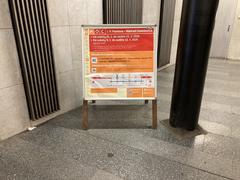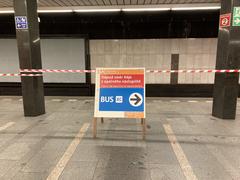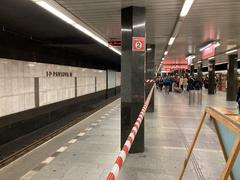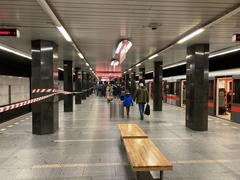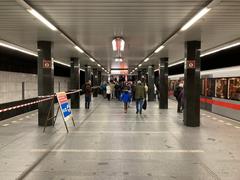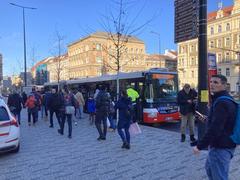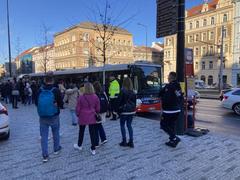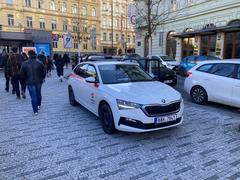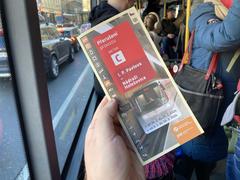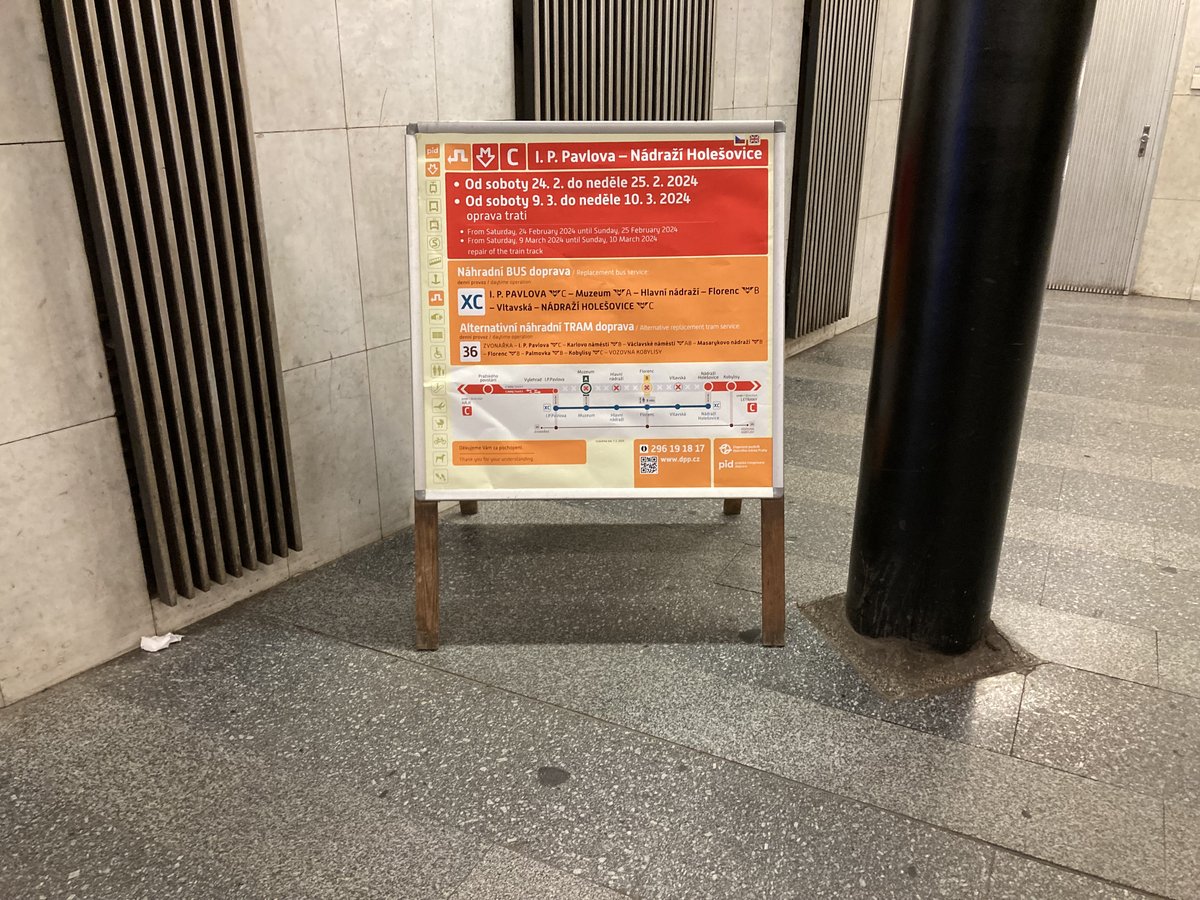
I. P. Pavlova Prague: Visiting Hours, Tickets, and Historical Site Guide
Date: 14/06/2025
Introduction to I. P. Pavlova and Its Significance
Located in the dynamic center of Prague, I. P. Pavlova is a crucial urban crossroads and transport hub that reflects the city’s layered history and evolving urban landscape. Once a prestigious residential area, the square has transformed into a busy intersection linking Prague’s neighborhoods and serving as a gateway for both locals and visitors. Its metro station, extensive tram network, and integration with major city roads make it one of Prague’s busiest and most accessible nodes (Radio Prague International; Virtual Prague; Prague.org).
Surrounded by a mix of late 19th-century Neo-Baroque, Art Nouveau buildings, and modern utilitarian structures, I. P. Pavlova is not only a transport hub but also a springboard to some of Prague’s most celebrated cultural, historical, and dining destinations. Recent urban renewal efforts are reshaping the square to foster greater pedestrian accessibility and enhance its public life, ensuring it remains welcoming for everyone.
This guide provides in-depth, practical information—including transport connections, accessibility, nearby attractions, and dining options—to help you make the most of your visit.
Table of Contents
- Historical Background and Urban Evolution
- Visiting I. P. Pavlova: Practical Information
- Social and Cultural Transformations
- Architectural and Urban Features
- I. P. Pavlova Metro Station Guide
- Nearby Attractions, Dining, and Local Culture
- FAQ
- Conclusion
- References
Historical Background and Urban Evolution
Historical Naming and Early Development
Originally named Náměstí Komenského after the Czech scholar Jan Amos Komenský, the square emerged as a prestigious address in early 20th-century Prague, particularly within the affluent Vinohrady district. Its current name, I. P. Pavlova, honors the Russian Nobel laureate Ivan Petrovich Pavlov—a legacy of Soviet-era influences that persists to this day (Virtual Prague).
Urban Transformation
In the 1970s, the construction of the Magistrála (North-South Trunk Road) and the opening of the I. P. Pavlova metro station on Line C dramatically altered the area’s character. The square shifted from a leafy, pedestrian-friendly boulevard to a major traffic artery, encircled by busy roads and dominated by high-rise offices and residential blocks (Magistrala.eu). The introduction of the metro in 1974 cemented its role as a major city transport node, with daily passenger turnover exceeding 118,000 by 2008 (Wikipedia).
Visiting I. P. Pavlova: Practical Information
Access and Public Transport
- Metro: I. P. Pavlova station (Line C, red) connects directly to key city districts.
- Trams: Lines 4, 6, 10, 16, 22, and 23 intersect at the square, offering easy transfers (Prague.org).
- Buses: Several routes serve the area, connecting to the main train station and surrounding neighborhoods.
Visiting Hours and Accessibility
- Square: Open 24/7; no entrance fees or special tickets required.
- Metro: Operates from 5:00 AM to midnight.
- Accessibility: Most entrances feature elevators and ramps; the Legerova Street entrance offers the most comprehensive step-free access (DPP Prague Transport).
Best Times to Visit
Peak hours are weekday mornings and evenings. For a quieter experience, visit early mornings, late evenings, or weekends. Seasonal events occasionally transform the square with music, markets, and performances.
Social and Cultural Transformations
Urban Livability Challenges
The rise of the Magistrála and heavy traffic led to issues of noise, air pollution, and difficult pedestrian navigation, with crossings often favoring cars over foot traffic (Radio Prague International). Despite these challenges, the square’s centrality and high footfall have inspired ongoing improvement campaigns.
Revitalization Initiatives
Architects, civic groups, and the city have launched projects to humanize the space. Temporary events like the Open Stage I. P. Pavlova and proposals to expand pedestrian zones and greenery are gradually reshaping the square into a more inviting public environment (Magistrala.eu; Prague Morning).
Architectural and Urban Features
Built Environment
The square is characterized by a blend of historic architecture and modern infrastructure. While some plans for major demolitions in the 1970s were never fully realized, the juxtaposition of ornate facades with functionalist buildings tells the story of the area’s evolution (Virtual Prague).
Mobility and Traffic
I. P. Pavlova remains a vital traffic junction, with the Magistrála’s branches and numerous tram lines converging. Recent projects focus on improving pedestrian routes, cycling paths, and green spaces to balance vehicular dominance (Prague Morning).
I. P. Pavlova Metro Station Guide
Station Layout and Connectivity
- Design: Spacious single hall, two rows of columns; four exits to Jugoslávská, Lublaňská, and I. P. Pavlova Square.
- Trams: Lines 4, 6, 10, 11, 16, 22 (day), 51, 56, 57, 59 (night) serve the station.
- Buses: Lines 135, 176, 904, 907, 908, 910, 888, 905, 911, 148.
Ticketing
- Standard Ticket (Adult): CZK 40 (90 minutes, unlimited transfers).
- Seniors: CZK 20.
- Where to Buy: Ticket machines at the station, newsstands, PID Lítačka app.
- Validation: Use yellow stamping machines before travel.
- Luggage/Bicycles: Additional half-price ticket for large luggage; bikes allowed on metro, not on trams or buses (PID).
Accessibility
- Metro: Step-free access via Legerova Street lift. Other entrances may lack elevators.
- Trams/Buses: Many low-floor vehicles; real-time info via apps like Moovit (Moovit).
- Surroundings: Modern pavement and amenities; cobblestones in some historic areas.
Nearby Connections
- Key attractions: Wenceslas Square, National Museum, Vinohrady, New Town, Vyšehrad.
- Amenities: ATMs, pharmacies, eateries, hotels, coworking spaces (Ippavlova5.cz).
Nearby Attractions, Dining, and Local Culture
Major Sites Within Walking Distance
- Wenceslas Square and National Museum: Prague’s cultural boulevard and museum complex. National Museum open daily 10:00 AM–6:00 PM.
- Antonín Dvořák Museum: Baroque villa museum dedicated to the composer; open Tues–Sun 10:00 AM–6:00 PM.
- Vyšehrad Fortress: Historic citadel with gardens and cemeteries; open year-round, free entry.
- New Town (Nové Město): Charles Square, Dancing House, and more.
- Old Town and Jewish Quarter: Astronomical Clock, synagogues, and vibrant squares.
- Petřín Hill: Park with panoramic views and lookout tower.
- Vltava River Cruises: Scenic boat tours.
Dining and Nightlife
- Traditional Czech: Čestr Restaurant, Kantýna.
- International/Michelin: Field, La Degustation.
- Casual Eats: Bakeries and cafés for koláče, trdelník.
- Beer & Pubs: Beer Time Pub, beer gardens at Letná Park.
- Tips: Tipping 10% is customary; lunch specials offer good value.
Local Culture
I. P. Pavlova’s surroundings host a mix of students, commuters, expats, and tourists. Vinohrady is especially known for its LGBTQ+ venues and lively cafés. Cultural events, music festivals, and markets often enliven the square and nearby districts (ExploreCity.life).
FAQ
Q: Are tickets required to visit I. P. Pavlova square?
A: No, the square is a public space and free to visit at any time.
Q: Which public transport lines serve I. P. Pavlova?
A: Metro Line C, tram lines 4, 6, 10, 16, 22, 23, and numerous buses.
Q: Is I. P. Pavlova accessible for people with disabilities?
A: Yes, with step-free metro access via Legerova Street and many low-floor trams/buses.
Q: What are the best nearby attractions?
A: Wenceslas Square, National Museum, Vyšehrad, Vinohrady, and Old Town.
Q: Where can I try traditional Czech beer nearby?
A: Beer Time Pub and Letná Park’s beer gardens.
Q: Are there guided tours starting from I. P. Pavlova?
A: Many city tours pass through or start near I. P. Pavlova due to its central location.
Conclusion
I. P. Pavlova stands at the intersection of Prague’s past and present, offering unmatched connectivity to the city’s historical, cultural, and culinary highlights. Its ongoing transformation—balancing mobility, sustainability, and public life—makes it a compelling destination for any visitor. Whether you’re using it as a starting point for exploration, sampling local cuisine, or experiencing the city’s urban energy, I. P. Pavlova enriches every Prague journey.
For up-to-date transit info and event listings, consult official Prague transport resources and consider using the Audiala app for real-time updates.
References
- Radio Prague International
- Virtual Prague
- Prague.org
- Ippavlova5.cz
- PID
- Moovit
- Time Out Prague
- Voices of Travel
- Prague Morning
- Magistrala.eu
- ExploreCity.life
- DPP Prague Transport
Download the Audiala app for real-time public transport updates, offline maps, and insider travel tips. Follow us for the latest on Prague’s urban renewal and cultural events!
